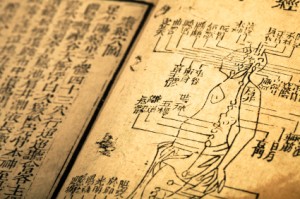Traditional Chinese Medicine, or TCM, has 8 main modalities. My work focuses on four of those: Acupuncture, herbal medicine, dietary therapy, and Tuina medical massage. While TCM may be a newer systematization, Chinese medicine (also called Oriental medicine, or OM) has been in use for thousands of years.
The medical philosophy from which TCM arises sees the body as a reflection of the natural world. The scholar-doctors who created this philosophy lived a life deeply in tune with nature, the turning of the seasons, the movements of the sun and moon, and the heavenly energies. They saw humans as a microcosm of the world in which we live. They saw every phenomenon in the world around us – Heat, Cold, Wind, Dampness, Dryness – reflected within us.
When we receive acupuncture or take herbal medicine, we are working to restore harmony to the body, to make sure all of these natural phenomenon are in balance and cooperation.
As practitioners, we restore balance through the meridian system of acupuncture (also known as Channel Theory), the Five Elements and through the Zangfu organ system of acupuncture and herbal medicine. The meridian system is like a network of invisible highways and byways that cover the entire body. From a Western biomedical vantage point, the meridian network is kind of like the system of blood vessels, bringing nutrition to each cell in the body. Instead of Blood, it is our Qi (pronounced “chee”), or vital energy, that moves through the meridians.
When areas along the meridians get clogged or become weak, like a traffic jam on a highway or an overpass in need of repair, we see signs of disease. The body cannot maintain balance when this happens, and illness is born. Acupuncture works to activate and mobilize Qi for therapeutic purposes. Herbal medicine does the same thing, but works from the inside out because each herb we use has an affinity towards certain meridians, Zangfu organs and areas of the body.
Disease can also be interpreted from a Five Elements perspective. The Five Elements are Wood, Fire, Earth, Metal and Water. In a state of health, these elements are in balance. One transforms into the next and a cyclical sharing of Qi is achieved. This is homeostasis. Like guests at a dinner party, sometimes there are personality clashes that make things uncomfortable. We use acupuncture and herbal medicine to settle these disputes and regain balance and harmony.
Acupuncturists also use a system of diagnosis called Zangfu organ diagnosis, which understands disease from a Chinese medicine perspective of the internal organs. It is a more modern creation, but it is a powerful tool to treat disease. Acupuncture meridians and herbal medicine align with each internal organ, and so can be employed to treat diseases in the same was as Channel Theory or Five Element theory.
So what does all of this mean for you?

A side-by-side comparison of a matchstick, a hollow-bore needle (like in a doctor’s office) and an acupuncture needle.
Most importantly, it means that acupuncture and Chinese medicine can understand any disease considered. A key tenet of this medicine is the treatment of the individual and his or her unique symptoms. You can scroll down to see a list of what the World Health Organization says acupuncture treats, but I can tell you from clinical experience we go much beyond this list.
In China, you would likely have acupuncture daily or every other day to treat your ailments. In America, we usually only have one acupuncture treatment each week. By using herbal medicine, we can continue to receive treatments daily without seeing a practitioner for an acupuncture treatment. This is important in the treatment of chronic conditions to restore the body, and also for acute conditions to ameliorate symptoms more quickly.
A lot of patients ask about the needles we use for acupuncture. Firstly, it’s good to not that acupuncture needles are drastically smaller than the needles used to draw your blood or give you a shot in your doctor’s office. Acupuncture needles are only marginally thicker than a human hair. Needles are sterile and for single use only, and are disposed of after removal. Insertion of needles is generally painless. As the Qi arrives at the needle, sensations like heaviness, dull aching or distention can be felt. Generally speaking, acupuncture treatments are very relaxing, and most patients fall asleep during a treatment.
Below is a the World Health Organization’s (WHO) list of conditions treated by acupuncture. You can read more about my particular interests here: Dermatology, Men’s Health, and Pain Management.
- low back pain
- neck pain
- sciatica
- tennis elbow
- knee pain
- periarthritis of the shoulder
- sprains
- facial pain (including craniomandibular disorders)
- headache
- dental pain
- tempromandibular (TMJ) dysfunction
- rheumatoid arthritis
- induction of labor
- correction of malposition of fetus (breech presentation)
- morning sickness
- nausea and vomiting
- postoperative pain
- stroke
- essential hypertension
- primary hypotension
- renal colic
- leucopenia
- adverse reactions to radiation or chemotherapy
- allergic rhinitis, including hay fever
- biliary colic
- depression (including depressive neurosis and depression following stroke)
- acute bacillary dysentery
- primary dysmenorrhea
- acute epigastralgia
- peptic ulcer
- acute and chronic gastritis
To make an appointment with for treatment, please go to the Appointments page. If you have further questions, feel free to ask through the Contact page.


